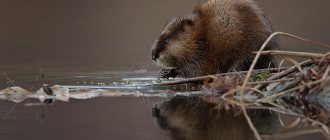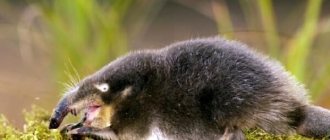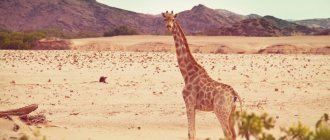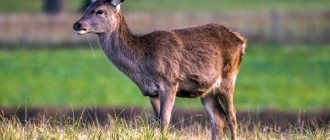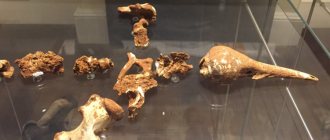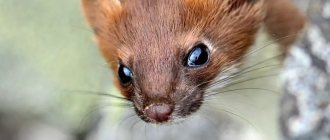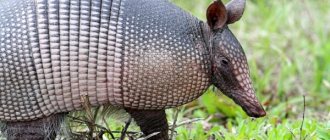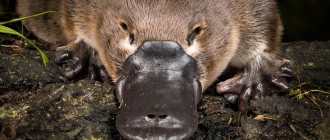The river beaver is the largest representative of rodents in our latitudes. The species, which was on the verge of extermination at the end of the last century, after the government adopted a set of measures, restored the population and developed suitable territories for habitation: Kamchatka, part of European Russia, the Yenisei basin and some others.
The fur of this animal is dense, rough and hard, and the undercoat is soft and delicate. Its wool is endowed with special properties, thanks to which it does not get wet at all. Adults are impressive in size, growing up to 1 meter in length and 30-40 centimeters in height. Body weight can reach 30 kilograms.
Habitat and diet of beavers
Beavers prefer to settle in calm, slow-moving bodies of water. Often a beaver dam can be seen from afar by tree trunks fallen along the river bank. The beaver dam is always located in the safest place for the family to live. The ideal habitat for it would be a reservoir, lake or forest river with sufficient food in the area. The last point is the main one when choosing a habitat for beavers, because the diet of these rodents necessarily includes a large amount of bark, herbaceous and aquatic plants. These animals love to eat egg capsule, sorrel, reeds and sedge. Among the variety of woody plants, preference is given to the bark of linden, aspen, and willow. For treatment purposes, beavers can eat pine and spruce bark.
These animals obtain food and materials for construction mainly at night. The beaver's teeth are extremely powerful, so the aspen trunk falls after 20-30 minutes of the rodent's hard work on it. Above thicker trees, such as oak, the animal can work for several nights on end. The beaver does not eat oak - it serves as the material from which the beaver builds a hut.
These rodents prefer trees with thin trunks. For such a tree to fall, it is enough to gnaw it on only one side. Beavers chew through thick plants using the hourglass principle. Animals gnaw through a tree trunk to reach young green shoots located at a height. In summer, the river beaver begins to work at dusk and continues to work until the first dawn. In autumn, the animal works much longer, as the duration of the dark period of the day increases. At this time, the beaver makes preparations for winter.
The beaver is a family animal, and the amount of food stored for the winter depends on the number of family members. Typically, one family eats several tens of cubic meters of branches over the winter. Warehouses are located at the bottom of the reservoir. There are times when beaver families find themselves on the brink of disaster. This happens when food supplies are washed away by the current. In this case, adult individuals are forced to leave their beaver lodges and go to land in search of food. Since beavers spend the winter in a safe and comfortable home, they are not in danger. But, coming out, slow and clumsy, they themselves become food for the predatory inhabitants of the forest. According to researchers, in order to replenish nutrients and vitamins, beavers sometimes eat their waste.
Population and species status
Not so long ago, common beavers lived almost throughout the entire territory of the Euro-Asian continent. Due to uncontrolled hunting, the total number of such mammals has decreased significantly. This leads to the fact that these animals are on the verge of extinction, so the number of beavers in our time can, as they say, be counted on one hand.
Just two centuries ago, not a single beaver remained in the territories of some countries of Asia and Europe. As a result, these countries had to resort to a number of measures to restore and then maintain the numbers of such animals. In the central part of our country, there is also a small population of beavers.
Where do beavers live?
The beaver builds three housing options for himself:
- Hut
- Half-hat
- Nora
If environmental conditions allow, a family of river beavers settles in a burrow with an underwater entrance. A beaver can dig a hole if the soil in the chosen area is dense and the bank of the reservoir is high. The walls of the burrow passages, which lead to numerous holes and chambers, are reliably compacted. There are usually several entrances and exits in a burrow. In our latitudes, soft, loose soil and a gently sloping shore prevail, so a beaver hut is more common than a burrow.
What is a hut?
A beaver's hut is the dwelling of this animal, which in appearance resembles the roof of a Ukrainian hut, the materials for which are branches of different sizes, clay mixed with silt, and grass. Initially, beaver huts have only one large room up to 2 meters wide and 1.5 meters high. The entrance to the house that beavers build is located below. The frame of the house is made up of large branches, and the gaps between them are filled with small twigs and grass. The animal covers the floor of its home with a dense layer of shavings. Beaver huts have smooth walls from the inside, because the animal removes every protruding twig using its sharp teeth. To make the shelter windproof, the rodent carefully coats the walls with a substance of silt and clay. The beaver builds the hut for about two months, and during this time he completely equips it, making it reliable, durable, and warm.
Since beavers spend the winter in their safe home, they are not afraid of forest animals. They simply cannot penetrate their home, the walls of which are strengthened and cemented from low temperatures. The beaver's hut maintains a positive temperature even in thirty-degree frost. Cases of a rodent's home being destroyed by a bear or wolverine are rare. Often in such a situation, all family members remain alive, as they manage to hide in the pond and stay under water for up to a quarter of an hour without harm to their health. Sensing a threat, the beaver makes a loud slap, similar to a weapon, notifying its relatives of trouble, and swims under the water. This sound is loud, distinct and sharp, and can be heard several hundred meters from the source.
Nutrition
These animals are exclusively herbivores. However, their diet cannot be called poor. Zoologists studying their life and feeding methods claim that their menu includes about three hundred different plants. The availability of rich and varied food is another criterion according to which these animals act when choosing their place of settlement. Consuming bark while working, they love to feast on willow, linden, aspen, birch, poplar, alder and the waste of many other trees. They also eat sorrel, nettles, sedge, reeds, and are incredibly fond of water lilies.
Beavers are very economical, care about the well-being of family members, and therefore make numerous reserves for the winter. They carefully and painstakingly place tree branches on the bottom of the reservoir, where they create a kind of “cellar.” A huge family of beavers is capable of storing more than a dozen cubic meters of such food for the winter. Sometimes it happens that the contents of the pantry are carried away by the river. And then the animals have to leave their cozy shelters and go out into the cold in search of food. This is not only unpleasant, but also dangerous, because in such a hungry time, it is easiest to become prey for predators, for example wolves.
People can also be dangerous for these hardworking and harmless animals. Beaver hunting officially begins in Russia in late autumn and continues until early spring. Fans of this activity, of which there are quite a lot, notice that these creatures are extremely careful. It is best to hunt them armed with a gun.
If you use a trap to catch animals, their valuable fur can be seriously damaged. The meat of these animals is red in color and is considered acceptable for consumption. It tastes like hare. However, it has a peculiar taste, and therefore special seasonings are used to prepare it.
The skins of killed animals are often sold to furriers. A beaver fur coat is considered a luxury, looks elegant and can be very warm. It is believed that such high-quality products, subject to all storage and wearing rules, can last at least a couple of decades. Beavers have been hunted since ancient times for their meat and warm fur. But besides this, the so-called beaver jet . What it is?
The fact is that these animals have a special gland located in the anal bodily area. Outwardly, these are like two bags connected to each other, producing a special secret. This substance is extremely odorous, and therefore beavers use it to mark their territory. However, people even in ancient times noticed that it has effective healing powers. And modern doctors have only confirmed this assumption.
"Multi-apartment" house for a large family
As the number of family members increases, the area of the home increases, turning into “multi-apartment” and even multi-storey housing. Thus, a previously one-room beaver hut turns into a complex multi-chamber room, increasing in height and width. Sometimes a hut in which a large family of rodents lives can reach 3-4 meters in height. Life in such an improved home changes dramatically. If in a one-room hut the animals rested and ate in the same place, then with the emergence of numerous extensions, separate rooms appeared for sleeping, usually located on the upper floors, and for eating, which were located on the ground floor. Beavers are neat people, so they closely monitor the order in their houses and throw out any leftover food into the water.
Half-hat as an interesting engineering solution
A semi-hut is a type of beaver dwelling formed as a result of changes in water level. As the water level rises, the hole begins to flood, so the animal begins to scrape earth from the ceiling to raise the floor level. Because of this, the ceiling begins to rapidly thin out and, in order to prevent its collapse, the rodent reinforces it with clay and fresh branches. Thus, the beaver converts an old hole into a semi-hut, so as not to build a new dwelling. From the outside it looks like a small pile of brushwood.
Water level is an unstable indicator, regularly changing under the influence of weather and seasons. In the summer heat, the water almost completely dries out, and during heavy rains it can rise significantly. All this makes it difficult for beavers to survive. To make life easier for itself, the beaver builds a dam.
The importance of beaver activity
The significance of beavers' activities is very great. For example, the construction of dams affects the groundwater level and the moisture content of forest peat. Insufficient moisture of this combustible material in forests significantly increases the likelihood of fires, which is very dangerous in the hot summer. Dams resulting from the construction of beaver dams become habitats for aquatic invertebrates. This attracts many waterfowl, which begin to nest near the reservoir.
Beaver Dam
A dam is a special hydraulic structure designed to prevent overflow and shallowing of a reservoir, built downstream from the beaver lodge. The size of this structure depends on the characteristics of the reservoir. If the river is small and its current is weak, then the dam will be small. The average dam does not exceed 30 meters in length, 4 meters in width, 3 meters in height.
To build a structure, beavers need a base in the form of a fallen tree or a natural narrowing of the riverbed. The frame of the dam consists of massive and long rods, stakes and branches. The cracks are filled with a mixture of silt and clay, as well as small branches and wood chips. To give additional strength, rodents use stones lifted from the bottom. After some time, the side parts of the structure begin to let water through, so the beavers begin to complete it. Due to this, over the years the beaver dam grows, becomes wider, stronger and more reliable, and is overgrown with bushes and trees.
The beaver family reacts to any breakdowns in the dam’s operation with lightning speed, setting off with the whole team to fix the problem. Since the nature of these rodents has not endowed them with good eyesight, they evaluate the condition of the dam only by sound. In other words, any suspicious murmur is a reason to diagnose the structure.
Sometimes a beaver dam is so strong that it can serve as a pedestrian bridge between the banks. In addition to this beneficial property, the dam helps to increase the fish population. This is why the beaver is an extremely useful animal.
What do beavers eat?
Beavers eat only vegetation; at their core, they are ardent vegetarians. Contrary to popular belief, they are indifferent to fish, shellfish and other underwater delicacies. The main diet consists of 200 types of plant foods. This includes shoots and bark of aspen, birch, willow or poplar. If their favorite tree varieties are not available, they can eat alder, oak, bird cherry and even elm. They usually build huts and dams from alder and oak, and make winter supplies from the tender tops.
Additionally, the diet includes water lilies, acorns, cattails, reeds, egg capsules, iris and other herbaceous crops that grow near water bodies.
Every day an adult can eat about 3 kg of plant food.
Well-developed teeth and strong intestines allow animals to cut and then digest tough plant foods. Beavers have a long intestine that is approximately twelve times the total body length. In addition, in the pyloric section of the stomach there is a sinus gland, which begins to work as soon as the cubs try adult food. Only wombats and koalas have this gland.
The summer diet is more varied, but in the winter the animals have to make supplies from bark and branches.
Surprisingly, beavers can harvest about 65 cubic meters of wood per family. To prevent food from drying out and freezing into the ice, beavers try to drown it so that it is below the level of water and ice shell. Therefore, when a reservoir is covered with a dense layer of ice, beavers have an abundance of plant food, which perfectly retains its quality in cold water.
Question to the expert
Do beavers eat the whole tree?
Beavers are reluctant to eat strong wood; they usually eat strong wood only during periods of hunger. But it’s not easy for animals to get to the tender foliage, so they knock down trees and eat the tops and side branches. Beavers use durable logs to build dams.
Water channels - a miracle of beaver engineering
When food supplies are depleted along the shoreline, these smart animals begin to dig a water channel deep into the forest. The width of such a building structure does not exceed 1 meter. The river builder uses these canals to transport branches and bark to build huts, strengthen dams, and provide food. Along them, the rodent moves to new, resource-rich areas of the forest. In addition, water channels often become a quick escape route for a family when threatened by predators. Diving into the canal, the beaver becomes inaccessible to animals.
Beaver habitats are usually located in relatively safe areas of forests, but cases of rodents dying in the mouths of animals do occur. Despite his intelligence and surprising foresight for an animal, the beaver often gets caught in the teeth of a bear, wolf, wolverine and some other predators, because on land it is slow and therefore helpless. Young rodents often become victims of large catfish, pike, and on the ground - foxes and raccoons. But excellent swimming otters and minks pose absolutely no threat to adult beavers.
The river beaver lives up to 15 years in the wild. In winter, adults begin the rut. It falls in January and February, and in the spring, in April-May, babies are born. One female can give birth to up to six beaver cubs. They are born practically blind, with a weight not exceeding 500 grams. Frail, tiny cubs are fed on their mother's milk until the end of summer. The female carries her children in her front legs, while moving on her hind legs alone. Juveniles often also stay with their parents over the winter. In most cases, beaver cubs live in their parents' hut for the first 2 years.
General information about animals
The habitat of beavers is small forest rivers, ponds, swamps, abandoned quarries, and canals. The main thing for these animals is that the reservoir does not freeze too deeply in winter and does not dry out in summer, as well as the availability of food of plant origin.
The beaver is a squat animal with short legs that reaches a length of 1 meter. Its body is covered with thick fur of decent length. The thirty-centimeter tail, reminiscent of an oar, is flattened and covered with large scales. It helps the animal to swim, dive and maneuver turns.
The hind legs have webs, thanks to which the animal feels comfortable in the water. His claws are strong and long. The ears are small, almost invisible on the head. But despite this, rodents have excellent hearing. Beavers see underwater thanks to reliable protection - the nictitating membrane. These animals walk on their hind legs when carrying something with their front legs, a branch, for example, or a baby.
How does winter go for beavers?
For almost the entire winter period, the beaver family does not leave their sleeping quarters. These rodents spend the winter half asleep, in a close and friendly family circle. Only occasionally do they go down to the supply store for a couple of branches for a snack. Sometimes, in the warm huts that beavers build for themselves, unwanted “tenants”—vipers and grass snakes—settle in for the winter. This animal is extremely hostile towards representatives of other families, so uninvited guests very quickly find themselves on the street with the joint forces of the beaver family. But the beaver has nothing against the proximity of a muskrat or muskrat during the cold season. The rodent tolerates their presence in its living space, but on the condition that the winter guest builds a separate chamber for himself and does not disturb the family.
Description and features
In the order of rodents, the beaver is considered almost its largest representative. In the Eastern Hemisphere, it has no equal in size. But in the West, only the capybara can compare with them - a mammal that is the champion in size among the rodents of the entire planetary fauna.
As for beavers, those that live in Eurasia are a meter in size, and even more, in size, while their weight reaches 32 kg. However, in Canada there are representatives of the beaver family that are much more massive. The weight of older individuals can reach 45 kg.
The photo shows a common beaver
And it’s not that beavers are purely fundamentally larger (usually just the opposite), it’s just that they grow not only in youth, but throughout their entire lives, and therefore in old age they can boast of record body weights. Moreover, in the competition between the sexes of these animals, living on both of these continents, it is the female specimens that dominate in everything, including size and massiveness.
It is also interesting that the ancestors of modern beavers - creatures that, according to various sources, originated in Asia or North America in the late Eocene era (40 million years ago) and existed on Earth later, had almost three meters in size and a weight of about 350 kg (this is eloquently stated evidenced by fossil specimens of those times, studied by paleontologists).
The modern beaver has the following appearance features. Its body looks squat due to disproportionately short legs, and the limbs themselves have five fingers equipped with powerful claws. The animal's head is small, its muzzle is elongated, its forehead is sloping.
The eyes stand out with small black circles, as does a fairly large nose. Beavers' ears are wide, short, as if cropped. These are semi-aquatic creatures, and therefore by nature they have many details of appearance that help them to have a comfortable existence in this environment.
And first of all, these are membranes on the paws and a paddle-shaped long tail, covered with sparse hairs and horny scales, as well as fur that is almost completely resistant to getting wet. The latter has a thick soft undercoat, on top of which thicker and coarser hair grows. This fur is shiny and incredibly beautiful; it can be black, chestnut of various shades or dark brown.
